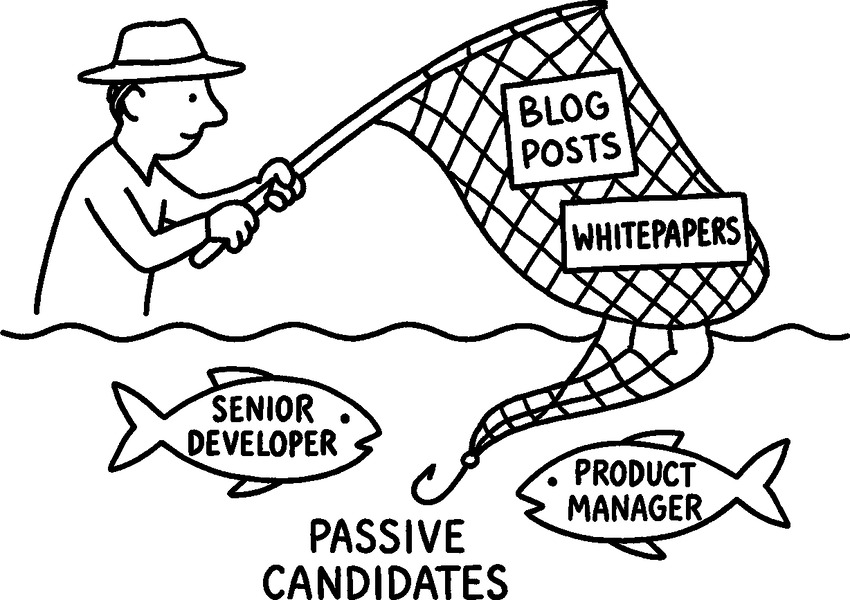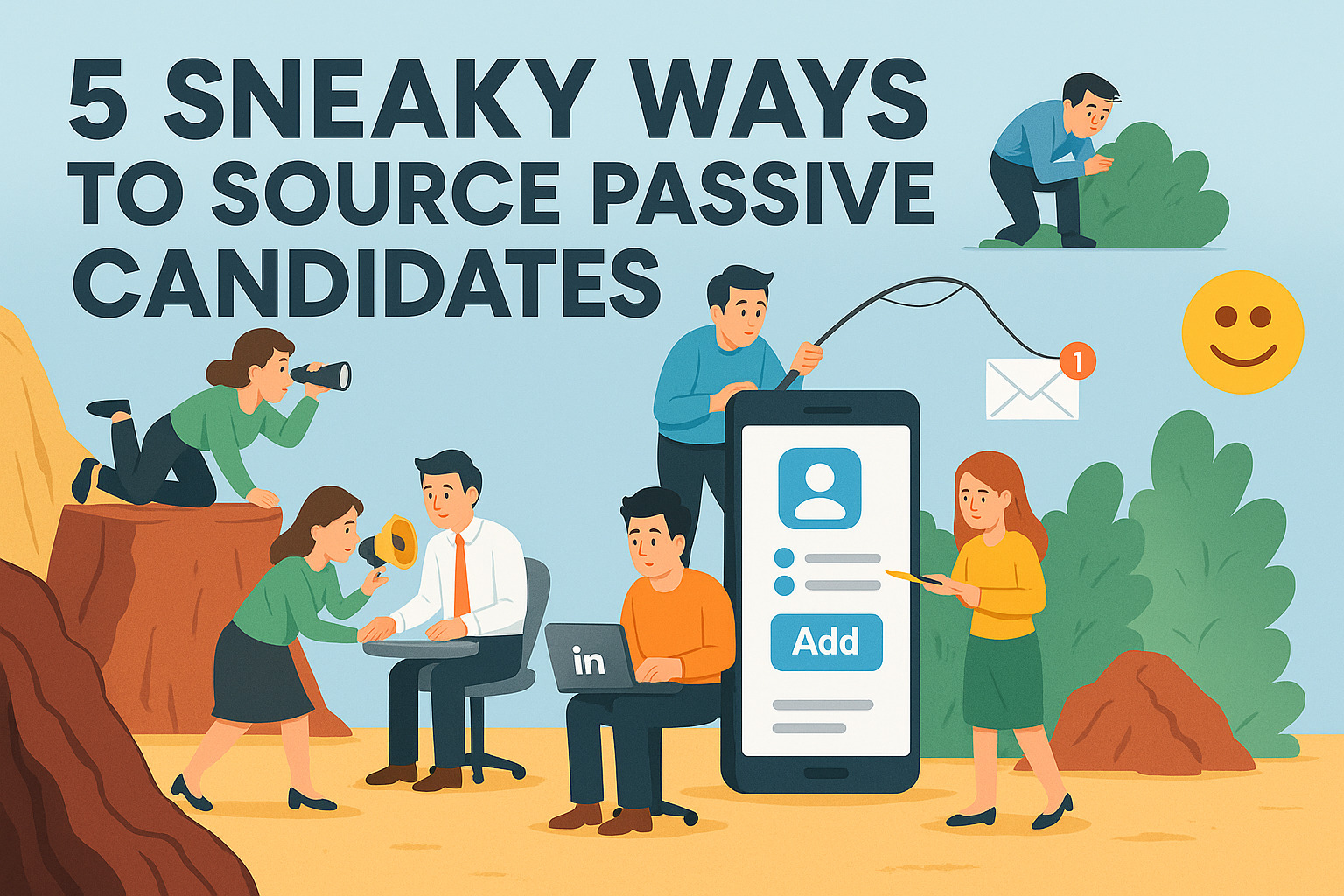Picture this: you’re a recruiter, staring at a job req that demands a unicorn—a data scientist with a PhD, 10 years of niche experience, and a passion for artisanal coffee. The active job boards? Dry as a desert. The usual LinkedIn searches? Same old faces. You need passive candidates—those elusive, happily employed folks who aren’t even thinking about jumping ship. But how do you find them without resorting to creepy DMs or spamming their inbox? I’ve spent years in the trenches of talent acquisition, and let me tell you, sourcing passive candidates is less about brute force and more about playing a sly, strategic game. Here are five sneaky ways to lure them in, inspired by real-world tactics and a dash of recruiter mischief.
First, let’s talk about social listening. No, I’m not suggesting you stalk someone’s Twitter rants (though, tempting). Social listening is about tuning into the digital chatter where professionals hang out. Think LinkedIn groups, industry-specific Reddit threads, or even niche Slack communities. For example, I once found a stellar UX designer by lurking in a subreddit dedicated to Figma plugins. She was sharing tips on workflow hacks, not job-hunting. A quick, personalized message later—praising her insight, not pitching a job—and we were chatting about her career goals. The trick? Use tools like Hootsuite or Brandwatch to track hashtags like #DataScience or #DevOps. Join the conversation, add value, and build trust before you even hint at an opportunity.
Here’s the deal: you can’t just barge into online communities like a pushy salesperson. Passive candidates will sniff out a generic pitch faster than you can say “InMail.” They’re not on LinkedIn daydreaming about your job ad—they’re swapping tips, debating tools, or venting about deadlines. So, get curious. Share a relevant article on Twitter about, say, Python frameworks, with a quick note: “This take on FastAPI vs. Flask is wild—any thoughts?” Or reply to a Reddit thread on data pipelines with a question like, “How’s Airflow holding up for you?” (Ok, you have to know a bit about the topic, so at least ask ChatGPT to help you out) You don’t need to be a tech genius; you just need to show you’re paying attention. Over time, you’re not some random recruiter—you’re that person who gets their world, and your outreach feels like a friendly nudge, not a cold call.

Now, let’s get a bit sneakier with employee referrals, but not the boring “post a job on the intranet” kind. Most referral programs are as exciting as a tax form. Instead, gamify it. I worked with a startup that ran a “Talent Scout” contest: employees who referred candidates got points for every step their referral cleared—interview, offer, hire. Top scorers won ridiculous prizes, like a weekend in Vegas or a custom bobblehead of themselves. Employees didn’t just refer their buddies; they dug deep into their networks, unearthing passive candidates who’d never have applied otherwise. (Research tells us that referred candidates are 55% more likely to accept an offer, so this isn’t just fun—it’s effective.)
Why does this work? Because passive candidates trust their friends, not recruiters. Your employees are already in the same LinkedIn groups, alumni networks, or conference circuits as your dream hires. But don’t just slap a bonus on referrals and call it a day. Make it personal. Host a lunch where employees brainstorm their networks. Ask, “Who’s the best engineer you’ve ever worked with?” Then, coach them on how to pitch the opportunity without sounding like a corporate shill.
Okay, let’s pivot to something a bit more… covert. Content baiting. Sounds shady, but hear me out. Passive candidates aren’t searching for jobs, but they’re hungry for knowledge. Create content that solves their problems or sparks their curiosity. A tech company I advised published a whitepaper on scaling Kubernetes in high-traffic environments. It wasn’t a job ad—it was a deep dive into a real challenge. They gated it behind a simple email signup. Within weeks, they had 200+ senior engineers in their talent pipeline, all passive candidates who’d never have clicked “Apply Now.” Share this stuff on LinkedIn, Twitter, or even niche forums, and watch the leads roll in.
Here’s the kicker: don’t make it about you. If your whitepaper screams “We’re hiring!” it’s game over. Focus on value. Teach them something they can use tomorrow, like a new framework or a career hack. A blog post on how to negotiate a raise without burning bridges will get you DMs from passive candidates asking about your open roles. Why? Because it earned their trust first.

Now, let’s talk about reverse sourcing. This one’s my favorite because it flips the script. Instead of chasing candidates, make them come to you. How? Build an employer brand so magnetic that passive candidates can’t help but notice. I’m not talking about cheesy “We’re a family!” posts. Think authentic, raw content. A fintech startup shares a video series called something like “A Day in the Life,” featuring engineers talking about real projects—warts and all. No polished PR nonsense, just candid chats about debugging at 2 a.m. or celebrating a product launch. They post it on LinkedIn and YouTube, and within months, passive candidates are emailing them, asking about openings.
But here’s where most companies screw it up: they think employer branding is about bragging. Wrong. It’s about showing the messy, human side of work. Share a story about a team that failed fast and learned faster. Post a photo of your dog-friendly office with a caption about work-life balance. Passive candidates don’t want a job; they want a mission, a culture, a vibe. And when 70% of the workforce is passively open to new roles, a strong brand is like catnip.
Finally, let’s get downright sneaky with alumni networks. Not your company’s alumni—your employees’ college or grad school networks. Most recruiters ignore this goldmine. I once helped a client tap into their CTO’s MIT alumni group. They didn’t post job ads; they hosted a virtual panel on AI ethics, inviting alumni to join. The CTO casually mentioned they were hiring. Result? Three passive candidates—two PhDs and a startup founder—applied within a week. Alumni networks are tight-knit, and passive candidates trust recommendations from their alma mater. Plus, platforms like LinkedIn let you filter by school, so it’s easy to start.
But here’s the rub: you can’t just spam these networks. It’s about building relationships. Attend an alumni event. Sponsor a scholarship. Or, if you’re on a budget, just ask your team to share a post in their alumni Slack. The key is subtlety—plant the seed, then let curiosity do the rest.

So, why does all this matter? Because passive candidates aren’t just a nice-to-have—they’re often the best talent. They’re employed, experienced, and selective, which means they bring stability and expertise. But they’re also picky. They won’t jump for a generic job ad or a cold email. You’ve got to woo them, charm them, maybe even trick them into noticing you. And that’s where the sneaky part comes in.
Now, let’s address the elephant in the room: isn’t this a bit manipulative? Sure, if you’re sending creepy “I saw you on LinkedIn” messages. But done right, these tactics are about building genuine connections. You’re not tricking someone into a job they’ll hate—you’re sparking curiosity about a role that could change their life. The line between sneaky and smart is thin, so always prioritize authenticity.
Here’s a confession: I used to think sourcing passive candidates was all about volume—blast enough InMails, and someone will bite. Boy, was I wrong. It’s about precision, patience, and a touch of creativity. I learned this the hard way when I spent weeks chasing a machine learning engineer who ghosted me after one email. Turns out, he was active in a TensorFlow forum. A quick question on his post about neural nets, and we were chatting offline. Lesson? Meet them where they are, not where you want them to be.
But there’s a bigger question lurking here: are we over-relying on tech to source passive candidates? AI tools can pinpoint candidates with scary accuracy, but they can also make us lazy. Algorithms miss the human spark—the engineer who’s a culture fit but doesn’t have the “right” keywords on her profile. Plus, there’s the risk of bias. If your AI is trained on historical hires, it might overlook diverse talent. So, while I love a good Boolean search (and trust me, I geek out over a well-crafted string), nothing beats human intuition for spotting hidden gems.
What’s next for passive candidate sourcing? Honestly, I’m not sure—and that’s what keeps me up at night. The rise of remote work and the gig economy is changing how people think about jobs. Passive candidates today might not even want a full-time role—they might want a side hustle or a six-month contract. And with platforms like X evolving, recruiters might need to get even sneakier, maybe tapping into decentralized networks or VR job fairs. The only certainty is that the game’s getting weirder, and we’ve got to stay nimble.
At Machine Hiring, we’re revolutionizing recruitment with our radically adaptable Applicant Tracking System. Unlike rigid platforms that force you to adapt your processes, we build custom solutions that conform to your unique workflows. From intelligent candidate sourcing to seamless integrations with your existing tech stack, our platform is designed to work the way you do—not the other way around. Whether you’re a staffing agency managing multiple client workflows or a tech company scaling rapidly, we create the perfect ATS for your needs. Want to see how a truly adaptable recruitment platform can transform your hiring process? Request a personalized demo and discover what’s possible when your ATS actually works for you.
Ready to stop wrestling with rigid recruitment software? Request your personalized Machine Hiring demo and experience an ATS that adapts to your unique hiring process—not the other way around.
Related Posts
- Unlock LinkedIn’s Hidden Potential: 9 Surprising Tactics for Recruitment Outreach Success
- Triple Your Talent Pool Overnight: The Untapped Power of Employee Referrals
- The Secret Weapon in Your Office: How Employee Referrals Transform Hiring
- Employer Branding: Your Secret Weapon to Attract Top Talent in 2025
- Sourcing Strategies That Actually Work: A Modern Recruiter’s Guide


